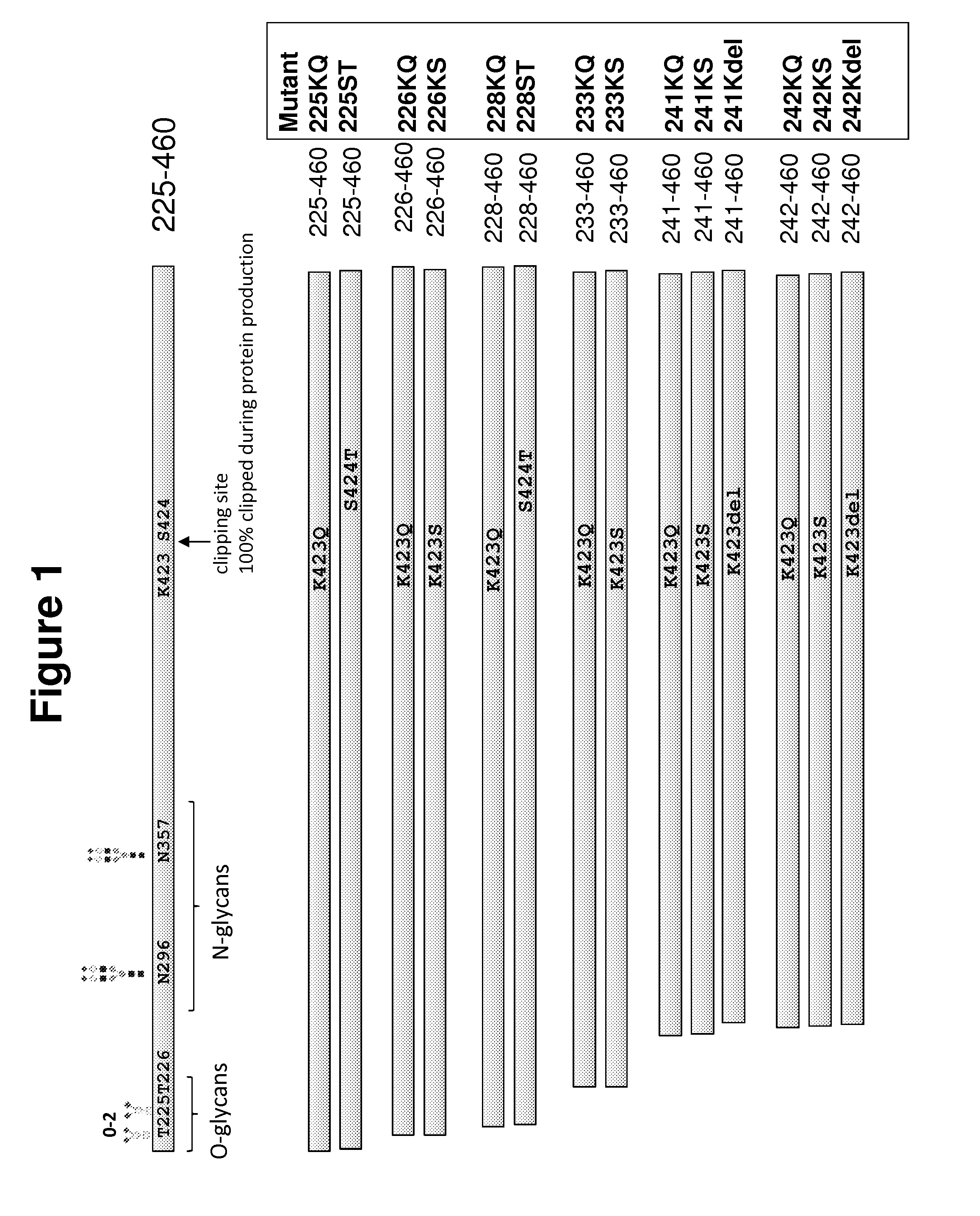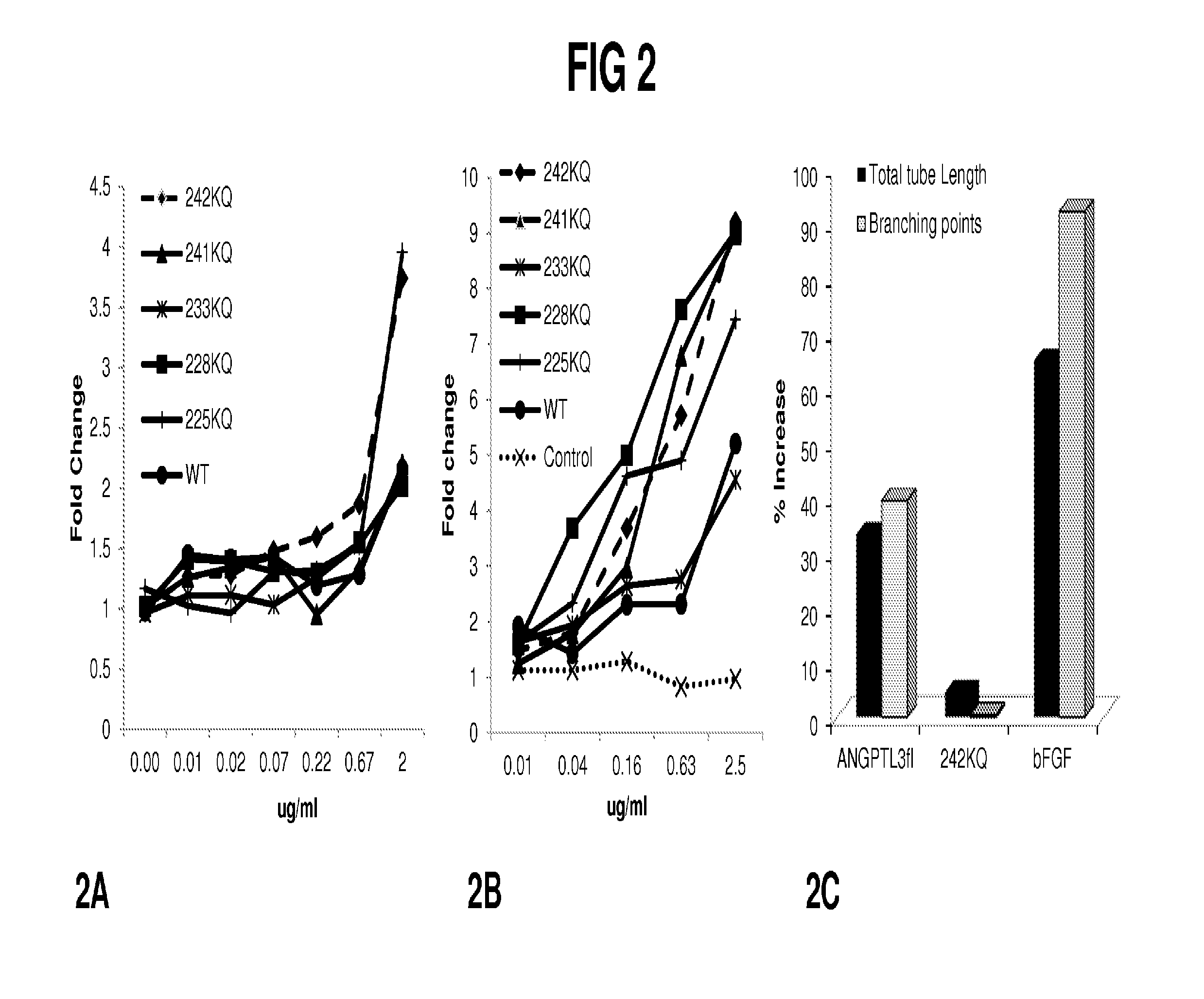Peptides and compositions for treatment of joint damage
a technology of peptides and compositions, applied in the direction of angiogenin, drug compositions, immunological disorders, etc., to achieve the effects of preventing arthritis, joint damage or joint injury, and improving pharmaceutical properties
- Summary
- Abstract
- Description
- Claims
- Application Information
AI Technical Summary
Benefits of technology
Problems solved by technology
Method used
Image
Examples
example 1
Protease-Resistant Angptl3 Peptide Constructs
[0104]Various N-terminal truncation mutants were constructed to remove O-linked glycosylations and facilitate biophysical protein characterization. To identify protease-resistant peptides, amino acid substitutions were introduced into various positions of human Angptl3 peptide fragments corresponding to the C-terminal region of the peptide. FIG. 1 shows positions of mutations in the human Angptl3. Constructs were initially prepared with His tags. The mutant proteins were: 225-460K423Q (225KQ), 225-460 S424T(225ST), 226-460K423Q (226KQ), 226-460K4235 (226KS), 228-460K423Q (228KQ), 228-460 S424T (228ST), 233-460K423Q (233KQ), 233-460K423S (233KS), 241-460K423Q (241KQ), 241-460K4235 (241KS), 241-460Kdel (241Kdel), 242-460K423Q (242KQ), 242-460 K4235 (242KS) and 242-460Kdel (242Kdel).
[0105]His-tagged proteins were expressed in HEK Freestyle™ cells and purified by Ni-NTA column chromatography. Tag-less C-terminal constructs were also cloned, p...
example 2
Integrin Binding Assays
[0107]aVI33 integrin Prepared peptides 225KQ, 228KQ, 233KQ, 241KQ and 242KQ were tested in vitro for binding to αVβ3 integrin. Briefly, Maxisorp plates were coated with 2 μg / ml Integrin aVB3, and various concentrations of polypeptide construct (indicated) were added. Bound peptide was detected by the addition of Anti-ANGPTL3 mAb followed by horseradish peroxidase-conjugated Goat anti-Mouse IgG antibody. All tested peptides retained or improved integrin binding capacity. EC50 for each were determined from the binding data, and results are shown in TABLE 2.
TABLE 2In vitro binding of ANGPTL3 and engineeredpolypeptide constructs to Integrinsα5β1 integrin EC50αVβ3 integrin EC50WT3.0543.245242KQ1.5663.076241KQ2.6934.032233KQ13.836.636228KQ4.264.051225KQ19.8911.18
[0108]α5β1 integrin Prepared peptides 225KQ, 228KQ, 233KQ, 241KQ and 242KQ were tested in vitro for binding to α5β1 integrin. Plates were coated with 2 μg / ml as described above but with Integrin α5β1, and va...
example 3
Functional Analysis of Constructs
[0109]Cell culture and differentiation. Primary human bone marrow derived mesenchymal stem cells (hMSCs) were FACS sorted and proven to be >98% positive for CD29, CD44, CD166 and CD105 and 98% positive for CD166 and CD105. hCR-MSCs were cultured up to 20 passages with no alteration in the cell profile, growth or differentiation rates identified.
[0110]Chondrogenesis. Peptide constructs of the invention were evaluated in physical and functional assays to assess chondrogenesis activity.
[0111]Engineered constructs provided herein are derived from ANGPTL3 which belongs to a family of seven identified ANGPTL proteins that have structural similarity to the angiopoietins, but lack the ability to bind the Tie2 receptor and thus have distinct functions. ANGPTL proteins contain an N-terminal coiled-coil domain (CCD) and a C-terminal fibrinogen-like domain (FLD), and are believed to be tightly regulated by their microenvironment and interactions with the extrace...
PUM
| Property | Measurement | Unit |
|---|---|---|
| Fraction | aaaaa | aaaaa |
| Composition | aaaaa | aaaaa |
| Biocompatibility | aaaaa | aaaaa |
Abstract
Description
Claims
Application Information
 Login to View More
Login to View More - R&D
- Intellectual Property
- Life Sciences
- Materials
- Tech Scout
- Unparalleled Data Quality
- Higher Quality Content
- 60% Fewer Hallucinations
Browse by: Latest US Patents, China's latest patents, Technical Efficacy Thesaurus, Application Domain, Technology Topic, Popular Technical Reports.
© 2025 PatSnap. All rights reserved.Legal|Privacy policy|Modern Slavery Act Transparency Statement|Sitemap|About US| Contact US: help@patsnap.com



